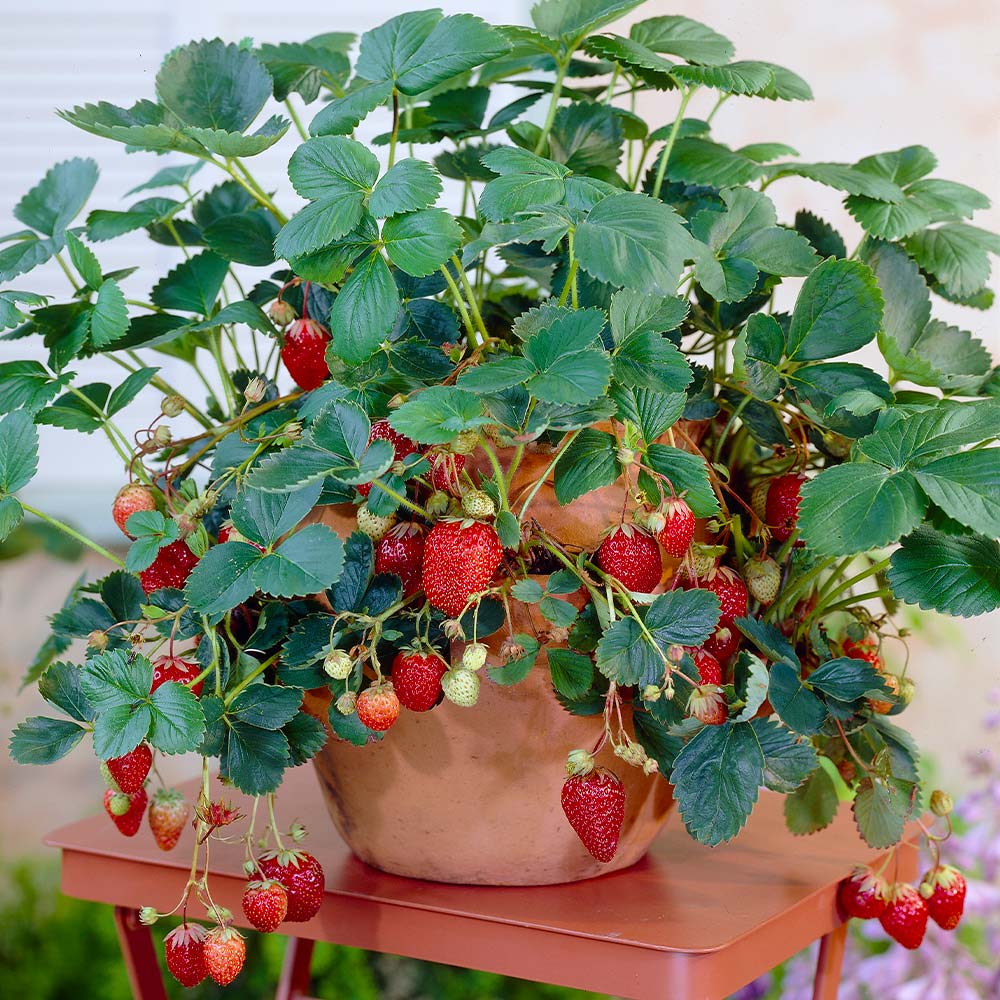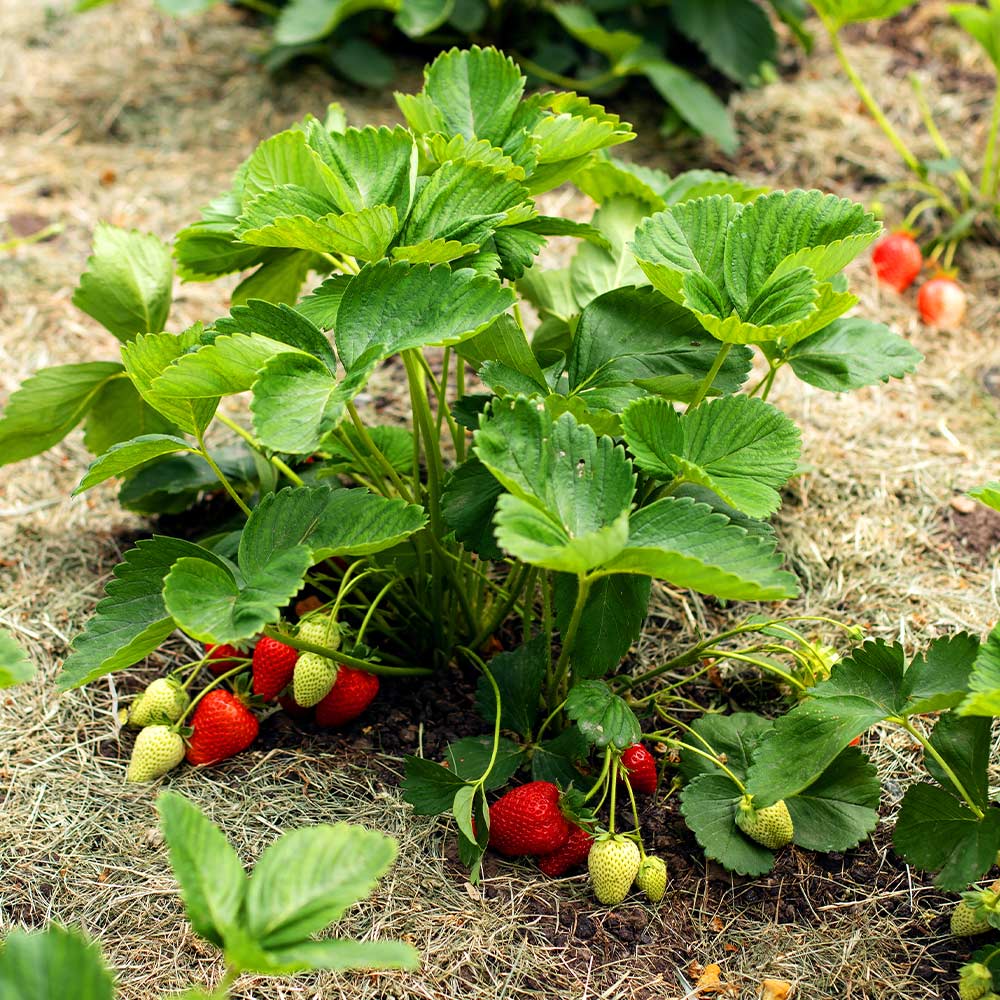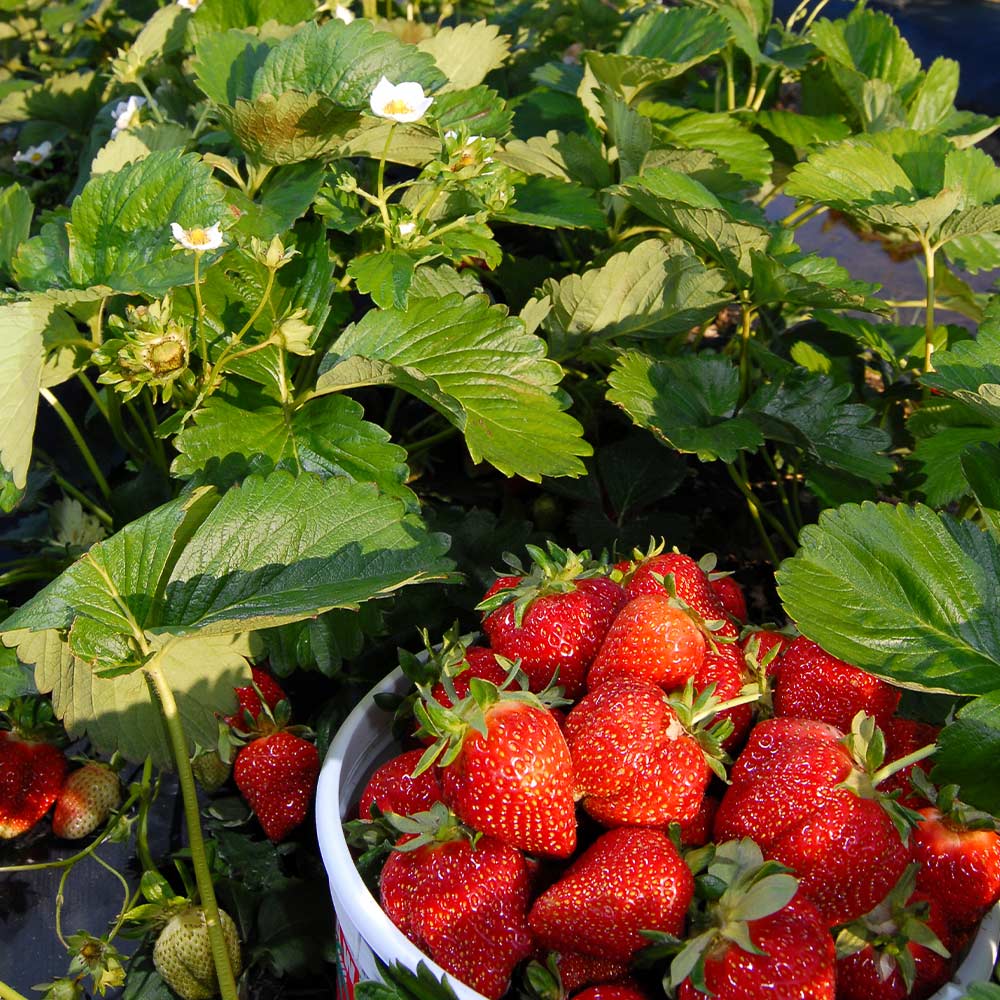* Images shown are of mature plants

Have questions? Talk with our Plant Experts (800) 973-8959
Save 25% on $200+ with code FALL25.
Questions? Call our plant experts: (800) 973-8959
Multiple Harvests of Juicy Strawberries
Everbearing Strawberries--a low-maintenance, high-yield favorite among strawberry lovers--is extremely popular due to its ability to produce well after spring ends. In fact, Everbearing Strawberries are often harvested as late as the first frost! That means that you'll enjoy delicious, juicy strawberries for many months to come.
You'll love the ease of preparation, planting and care of your new plant, because the Everbearing will require very little attention, except when you're pulling off countless plump, red strawberries
Most strawberry varieties come in all at once. Everbearing allows you to enjoy fresh strawberries over several months. Since the harvest is spread out... you need more plants. This is why we are making them so affordable. You will have your own backyard strawberry factory with plenty on hand for breakfast, smoothies, treats and to share.
The value you'll receive from your Everbearing Strawberry plants will continuously replenish your fruit basket--and your wallet! The large and luscious berries you'll grow yourself, not only taste amazing, you'll reap the many commonly known health benefits from eating this vitamin-rich fruit grown right in your own garden--pesticide free, ready to pluck, eat and enjoy.
This versatile plant can be used in just about any location you desire--ground cover, containers, even decks and patios--the Everbearing Strawberry is a plant that will adapt to almost anywhere. So attractive, it can be used in your front yard or back.
You can expect one harvest in the late spring, followed by another in the fall, then a possible third harvest in late fall! And leftover Strawberries can be easily frozen and kept until you are ready to serve.
Pollination Info
Everbearing Strawberry Pollination
Everbearing Strawberrys are self-fertile. You will get fruit with only one plant. However, adding an additional Everbearing Strawberry will drastically increase the size of your crop.
Planting & Care
The Everbearing Strawberry is a hybrid species that is cultivated worldwide for its fruit, the strawberry. The fruit (which is not actually a berry, but an aggregate accessory fruit) is widely appreciated for its characteristic aroma, bright red color, juicy texture, and sweetness. It is consumed in large quantities, either fresh or in prepared foods such as preserves, fruit juice, pies, ice creams, and milkshakes. Artificial strawberry aroma is also widely used in many industrialized food products and in other industries for their scent such as bath and shower gels. Everbearing Strawberry Plants harness this desirability of the fruit and allow for an all year-round yield.
Seasonal information: Early spring is the best time to plant Everbearing Strawberry Plants. Cover the roots with soil, leaving the crown of the plant at the soil’s surface. During the first season, remove all blossoms from June-bearing plants. This will make your Strawberry harvests larger and the plants will send out more runners in subsequent seasons.
Location: Everbearing Strawberry Plants prefer a soil rich in all the basic nutrients, with a pH of 6–6.5. Everbearing Strawberry Plants plants are susceptible to root rot and must be planted in well drained soil, with crown set at soil level.
Planting instructions: Try to plant Everbearing Strawberry Plants on a cloudy day or during the late afternoon.
1) Set the Everbearing Strawberry Plants in the soil so that the soil is just covering the tops of the roots. Do not cover the crown.
2) After four or five weeks, the Everbearing Strawberry Plants will produce runners and new daughter plants.
Watering: Water your strawberries as close to the soil as you can to avoid excess moisture on the leaves. The soil needs to stay moist but not overly saturated (avoid standing water). We suggest watering a few times a week and adjusting for your local weather. If you’re unsure when to water, stick your finger in the soil a few inches down to feel the soil moisture. If it feels dry, water!
Fertilization: Start with a rich, organic soil. Apply a balanced fertilizer (10-10-10) at planting at the rate of one pound per 100 sq. ft. Fertilize again after renovation of June bearers or second harvest of day neutrals and Everbearing Strawberry plants types. Do not over fertilize or you will have excessive leaf growth and poor flowering. Do not fertilize Everbearing Strawberry Plants late in the season in colder climate to prevent new growth that will be damaged by frost.
Weed Control: In addition to the watering and fertilizing, it is important to keep your Everbearing Strawberry Plant patch weed-free, especially since weeds will steal moisture and nutrients from your shallow-rooted Everbearing Strawberry plants very quickly. Keep your berries harvested, and remove any rotting fruit immediately.
Pests and Disease: Around 200 species of pests are known to attack Everbearing Strawberry plants, both directly and indirectly. These pests include slugs, moths, fruit flies, chafers, Strawberry root weevils, Strawberry thrips, Strawberry sap beetles, Strawberry crown moth, mites, aphids, and others. The Strawberries are subject to damage from gray mold, rhizopus rot, and leather rot. The Everbearing Strawberry Plants can also develop disease from temperature extremes during winter. Birds love your strawberries! protect them with some means of wildlife netting or bird nets.
Pruning: You should regularly prune your Everbearing Strawberry Plants to maintain a healthy grow cycle.
Pollination: Spun-bonded row covers may also be used to speed harvest. Row covers are applied at the time of winter mulch removal and are left in place until flowering begins. This practice can speed harvest by as much as a week. Row covers must be removed at the time of flowering so pollination can occur. Fruits normally mature 28 days after pollination.
Shipping Details
Estimated Shipping Time: Most orders ship immediately. As noted on the website, some items are seasonal, and may only ship in spring or fall. Once your order is shipped, you'll receive an email with a tracking number.
| Amount of Order | Shipping Charge |
|---|---|
| Less than $49 | $19.95 |
| $49 + | FREE SHIPPING! |
Product Details
| Mature Height: | 8-12 inches |
| Mature Width: | 1-2 ft. |
| Sunlight: | Full Sun |
| Growth Rate: | Slow |
| Harvest Time: | May - August |
| Year to Bear: | Can Fruit the 1st Year! |
| Botanical Name: | Fragaria ananassa 'Delizz' |
| Does Not Ship To: | AZ |
| Grows Well In Zones: | 4-9 outdoors |
| Your Growing Zone: | # |











